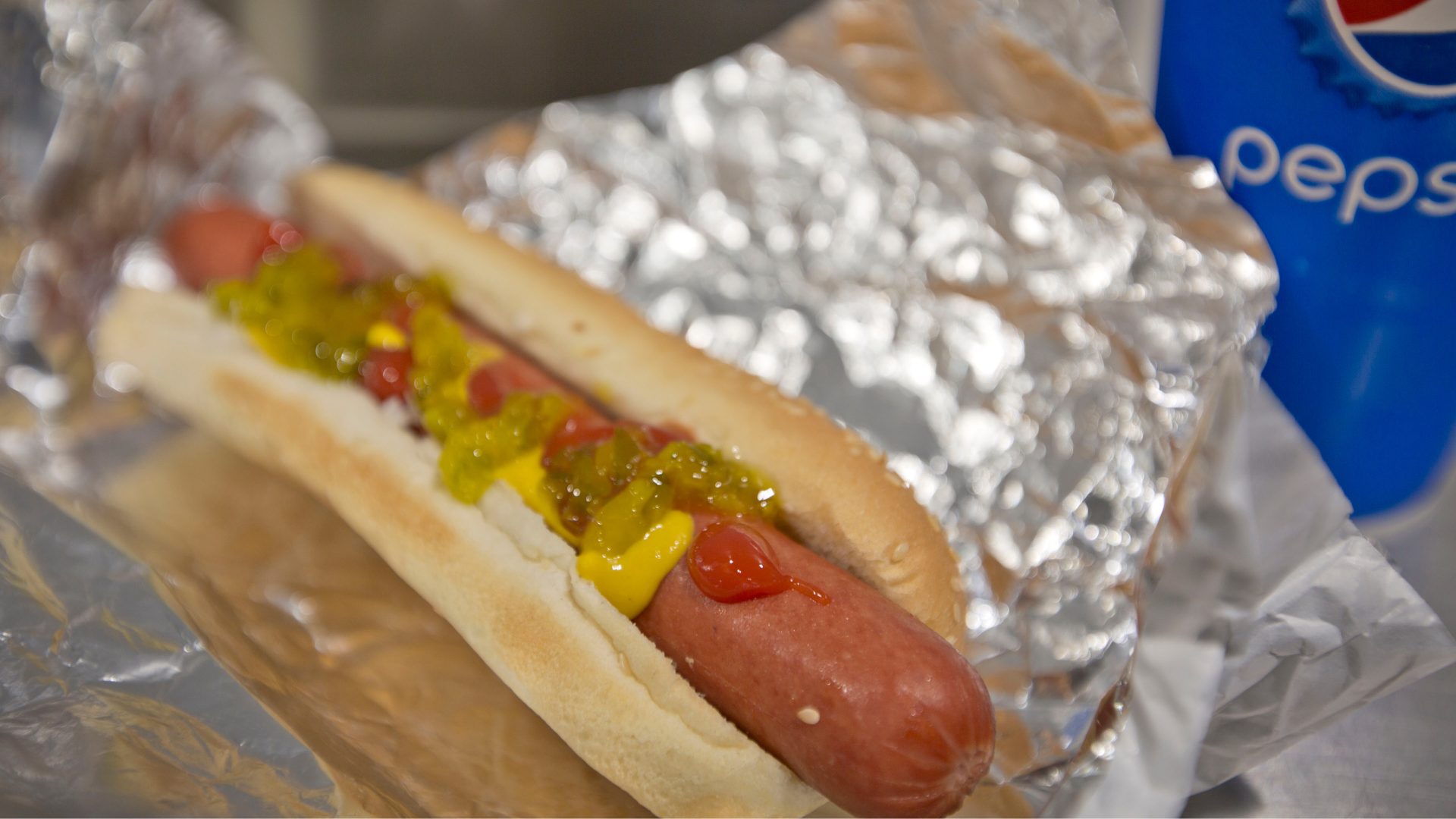Amazon’s chief engineer used to have a dog named Rufus who ran up and down the halls fetching tennis balls. That doesn’t seem like a big deal for a multibillion-dollar business. But recently, Amazon brought Rufus back to the office in a big way as the name of its AI-powered digital shopping assistant, complete with the dog’s image as the mascot. Meanwhile, Walmart debuted its own AI-powered digital shopping assistant as the two retailers continue a dogfight with gigantic stakes. These high-tech helpers provide all sorts of information, answer questions, and make recommendations (read “sales suggestions”).
In a high-tech, high-stakes food fight, Seattle-based Amazon and Bentonville, Ark.-based Walmart are ramping up tech, rolling out AI, using their data as a huge resource, further automating the supply chain, debuting technologies to increase convenience, cut costs, lower inventory, and give each a competitive edge.
The result is a futuristic clash of companies and computers, with supermarket owners revolutionizing retail in super smart stores and far beyond as software becomes more important in selling their goods.
These dueling giants are continuing to grow as supermarkets, including market share, as they continue to invest in tech. Amazon’s second-quarter sales ended June 30 at $148.67 billion, up 10% from $134.4 billion. Its online store sales rose 5% to $55.4 billion after growing 7% in the first quarter.
Meanwhile, Walmart’s first quarter sales were $161.5 billion, up 6.0%. Walmart has been growing e-commerce and in-store sales, helping consumers find “what they’re looking for when they shop our app or site,” Walmart President and CEO C. Douglas McMillon said. E-commerce penetration is up in all our markets.”
The bigger fish, in other words, are getting bigger even as the lines between e-commerce and in-store sales blur. While growth can bring growing pains, technology is fueling, or at least facilitating, much of this expansion as supermarkets scale at a remarkable rate. Once a sleepy sector when it comes to tech, “super” sized supermarkets are now at the forefront of ways technology can impact the retail experience, if only because of their size, selection, and delivery speed.
AI on the Aisle
AI is at the heart of this “2.0” retail revolution, as Walmart and Amazon use their data to recommend products and boost sales. Digital shopping assistants can both grow sales and help consumers find what they want faster, even if they didn’t know they wanted it. Suggesting, really, is just another word for selling as AI shopping assistants become a retailer’s and shopper’s best friend.
“These advancements signal a new era in online shopping, transforming the way consumers interact with retailers,” Jack Lindberg of Mars United Commerce said of Walmart and Amazon’s use of AI to create digital shopping assistants.
Walmart CEO McMillon said they are “bringing new experiences to life, like generative AI-driven product searches that help our customers shop more intuitively.” Walmart’s AI can provide products to match prompts such as “Help me plan a football watch party” or “What supplies do I need for a newborn?”
Google may rule the search engine roost, but Amazon and Walmart are trying to rule retail search. “We’re able to understand our customers’ needs at an even deeper level and generate personalized responses and product suggestions,” according to Walmart. “Therein lies the magic.”
Meanwhile, Rufus, Amazon’s “AI-powered conversational shopping assistant,” helped millions of customers sort through a massive inventory for Amazon’s biggest Prime Day ever. Think of it as a kind of automatic or artificial salesperson (AS) that lets you find and shop faster with AI.
In-store
If AI is helping grow ecommerce, Amazon and Walmart also are making big changes in stores including, but not limited to, technology. Amazon pulled Just Walk Out, “fast, frictionless” technology from big grocery stores and went with a new approach. Amazon Fresh instead is using Amazon’s Dash Cart technology that lets shoppers scan items while shopping and pay by phone, eliminating the need for checking out.
However, technology is only part of what Amazon has in store. Whole Foods is launching Whole Foods Market Daily Shop, a quick-shop store format between 7,000 and 14,000 square feet compared to the typical 40,000-square-foot Whole Foods Market.
Walmart has been trying to improve the shopping experience, remodeling nearly 70 stores in the most recent quarter, and is on track to do more than 900 this year, according to McMillon. Growth, though, also means cutting back on things that aren’t working. Walmart recently decided to close its U.S. healthcare clinics, citing low reimbursement rates and the cost to serve.
“We could no longer see a path to achieving an acceptable level of profitability, and we’re committed to being disciplined with our investments,” according to Walmart.
Delivering Results
Both Walmart and Amazon specialize in delivering results and products quickly. Convenience matters as much as cost. “We’re focused on saving our customers both money and time,” McMillon said. “We’re people-led and tech-powered.”
That may sound like just another statement, but the focus on saving time and money is key. Convenience matters along with cost. This fight to save time and money is a hallmark of the smart shopping revolution as retailers compete for convenience. Amazon’s free delivery with Prime has been a key differentiator. But Walmart is boosting delivery as well as pick up at stores, recently introducing on-demand early morning delivery to customer doorsteps as early as 7:00 a.m. and as quickly as 30 minutes. Walmart’s same-day delivery is available at more than 6,500 locations worldwide.
“In Walmart US, over the last 12 months, 4.4 billion items were delivered same or next day, with about 20% of those delivered in under three hours,” McMillon said recently. “Delivery times are getting faster and the cost to delivery is coming down at the same time.”
Logistics
Amazon and Walmart are also investing in improved logistics. McMillon said Walmart is working to “create a more intelligent, flexible and automated supply chain” for its 4,600 grocery stores.
Walmart is building five new high-tech perishable distribution centers and expanding four traditional perishable centers by adding 500,000 square feet of automation per site to increase capacity for fresh products. “We’re adding state-of-the-art tech to our facilities to enable greater speed and capacity that allows us to serve customers even more reliably,” Dave Guggina, executive vice president of supply chain operations at Walmart U.S., said.
Walmart’s high-tech distribution centers can store and process twice as many cases as traditional centers, more than doubling the amounts processed per hour. Automated systems assemble intelligently layered pallets with more fragile items, such as eggs or fruit, toward the top.
Meanwhile, Amazon has become such an expert at delivery that it is delivering for other retailers, including grocery chains such as Lucky Supermarkets, owned by Save Mart. “We’re teaming up with third-party retailers we know our customers already love,” Carol Rogalski, an Amazon spokesperson, told Grocery Dive.
Advertising in the Aisles
While sales are up at both Amazon and Walmart, the two companies are also using their stores to generate revenue from advertisers rather than only from sales.
Walmart recently launched its Sam’s Club’s Member Access Platform, or MAP, which it says makes it the “first and only retail media platform to integrate ads in a mobile, self-checkout app experience.”
“This launch represents another step forward in Retail Media 2.0… blending … physical and digital experiences,” said Andrew Lipsman, founder and chief analyst, Media, Ads + Commerce
Sam’s Scan & Go adoption surged 50% for this opt-in feature in the past three years, including one in three Sam’s Club members. Diana Marshall, executive vice president and chief growth Officer at Sam’s Club, said this means the right “ads reach the right members at the right time in their shopping journeys.”
Walmart also gets data “to better understand member shopping behavior and ad performance” while helping “advertisers achieve their objectives.” Big stores get big data that they are now using to boost sales.
Pumping up Private Label
Inflation has pushed up prices everywhere, prompting Walmart and Amazon to push back, competing aggressively on price. The one thing that is not growing at Walmart and Amazon brick-and-mortar appears to be prices. Amazon’s CFO, Brian Olsavsky, recently said customers “are looking for deals” with lower priced products selling strongest.
“We’ve increased the number of promotions for our customers …,” Whole Foods CEO Jason Buechel told Yahoo! Finance. “As a result, we’ve actually seen double-digit unit growth in promotional items.”
Deals and discounts are proliferating at Amazon, and Walmart is holding down prices with its everyday low-price strategy. At the same time, Walmart and Amazon are boosting private label.
Whole Foods is expanding its private brands to offer more affordable options and battle inflation. The 365 by Whole Foods private label already offers more than 3,000 products, and more are in the works.
Meanwhile, Walmart recently rolled out a new private-label food brand called bettergoods, which McMillon called their “largest food private brand release in 20 years.” He said 70% of bettergoods items are priced under $5. Bettergoods proves that the world’s biggest retailers sometimes think big and small at once. Amazon and Walmart are growing, both in-store and online. Sure, they want you to have to decide where to shop. But ask Walmart and Amazon; they’d probably tell you they want your decision to be whether to shop online or in person, not where.
Louis Biscotti is the national leader of Marcum’s Food and Beverage Services group. He’s been an entrepreneurial leader in accounting for over 40 years, and is a frequent lecturer and published author on various financial and business topics. His expert advice has appeared in both national and local publications such as The Wall Street Journal, Newsday, Long Island and New Jersey Business News, Supermarket News, and Food Dive. He also founded a series of best practice forums for food and beverage companies, which attract nearly 500 senior executives annually, as well as an annual food and beverage survey.
About Marcum LLP
Marcum LLP’s Food & Beverage Services group has the perfect recipe of knowledge and service capabilities to help companies stay flexible. Marcum’s professionals provide the accounting, tax, and consulting services so that companies can concentrate on the growth of their business. Marcum serves a variety of food and beverage clients including distributors and manufacturers, importers, restaurant chains, processors and packaging, agribusinesses, and retailers. For more information, please visit marcumllp.com/industries/food-beverage.
Article featured in Forbes on August 12, 2024








